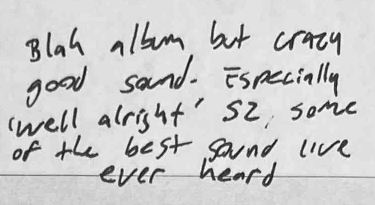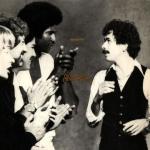Hot Stamper Pressings of Albums with Especially Dynamic Guitar Solos
In our most recent shootout (11/2023), the first we’ve done in quite a few years, my main listening guy was blown away by the sound of the Shootout Winning copy. This warmed my heart no end, as I have been raving about the sound of this album for fifteen years or more.
We created a section for phenomenally good sounding records such as Inner Secrets, and the link below will take you to it.
His notes from the session can be seen below.

And he’s not wrong about much of the album being “blah.” There are really only about four top quality songs out of the nine on the album, but three of those four are killer, and, even at our prices, make the album a Must Own for those of you with big speakers that can play good and loud.
Phase One and Phase Two of a Shootout
Like other Hot Stampers you may have read about, sometimes the instruments and voices just jump out of the speakers. When that happens I usually write “It’s Alive!” on the post-it, and I know exactly what to do with it. I put it right in the Contender pile, to be compared with the other top contender copies at some point.
It’s definitely a crazy-good Hot Stamper; just how hot we still need to find out.
Which is what happens in Phase Two of these affairs. We go back through all the best copies to see in what areas they really shine and in what areas they may fall a bit short of the best.
Of course there’s no way to know what accounts for any of the sound we hear. Not for sure anyway. It’s just interesting to ponder what makes one record sound one way and the next record, with stampers as little as one letter off in the alphabet — sometimes with exactly the same stampers! — sound so different from one another.
Doug Sax Is The Man
All the originals (the only ones with the potential for good sound in our experience) are cut by The Mastering Lab, one of the greatest cutting houses to ever master records.
Doug Sax may or may not have had anything to do with the making of this record, but one thing we can be sure of: he knew how to keep his lathes and amplifiers working at state-of-the-art levels. The sound quality is unsurpassed.
And he did it all with tubes.
He was very proud of his custom-made tube-driven cutting amps, designed by none other than his brother, Sherwood. His amps cut many of my favorite records of all time, including this one, an album that I have been using to improve the playback quality of my system for more than thirty years.
To this day we get taken to task by some regrettably misguided individuals for criticizing his work on the awful audiophile records he made in the 90s, many of them for Analogue Productions. We stand firmly behind the criticism we made of those albums decades ago. Their sound has not improved with age.
Those records from the 90s sound nothing like the records Doug and his crew were making in the 70s.
According to the logic of our critics, if you made great records in the 70s, then you must have been making great records in the 90s, whether your name is Doug Sax, Bernie Grundman, George Marino, Robert Ludwig or any other.
This is a very crude way of understanding the work of these exceptionally talented men.
The fact that this kind of sophistry is taken seriously by grownup adults in the audiophile community is embarrassing. To those of us who have been in the hobby for decades, it comes as no surprise.
Audiophiles have always embraced bad ideas (half-speed mastering!) and bad records (like those found here.) Our hobby attracts large numbers of True Believers, and many of them — too many of them — latch onto conventional ideas about records and audio which are attractively convenient and comforting.
Self-evident, convenient and comforting ideas — so beautiful and beguiling — rarely get put to the test. They are a ball some audiophiles have unknowingly chained to themselves.
These superficially attractive ideas do not hold up well to scrutiny. They are mostly assumptions, and we take issue with assumptions when it comes to finding better sounding records.
For those who would like a more thorough explanation of our approach and the heterodox views that result from it, we wrote about it here.
Uniquely among audiophile reviewers, empirical evidence, using large pools of data, all of it acquired scientifically, is at the heart of everything we think we know. And, as we freely admit, we still sometimes get it wrong.
Some quick notes about the best tracks on Inner Secrets follow.
